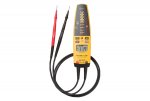I don't get this "solenoid testers don't lie" stuff. I have experienced it myself; sometimes, you get a weird reading that the stoic wiggy will not report with meaningful information, and you wind up grabbing something more accurate to figure out what's going on. If you have a damaged underground, for instance, a wiggy might just vibrate and show voltage. It might show less than 120v, but it doesn't give you accurate information. You wind up trying to figure out how to get a load on the circuit and a DMM to see what's going on; why not just use the tool that does just that?
Open neutrals, same story. It actually does matter that the voltage is increasing when you energize the load. The wiggy is too insensitive to do any good.
You might as well just carry around a trouble light on alligator clips, that will tell you as much as a wiggy and you get the fringe benefit of being able to read the paper while you work.



